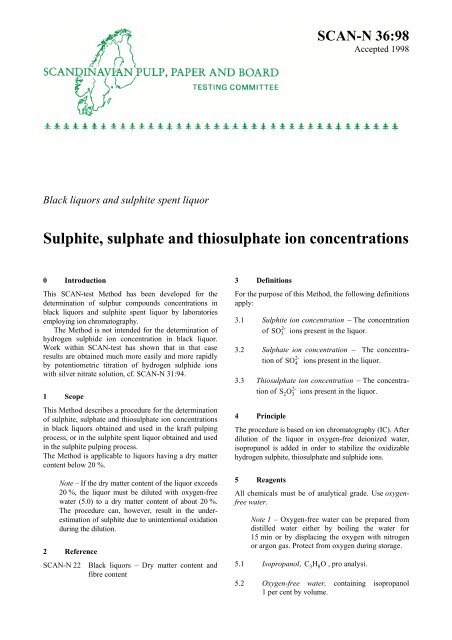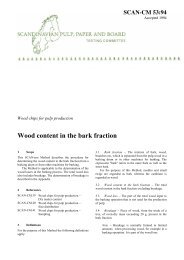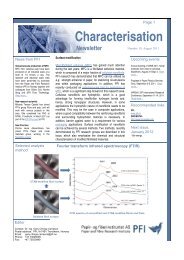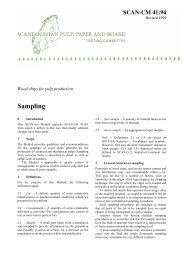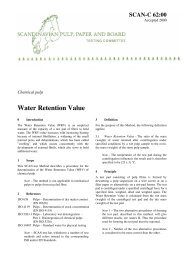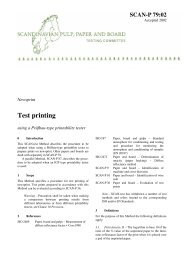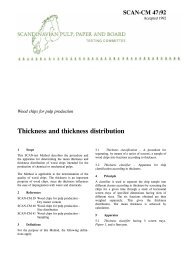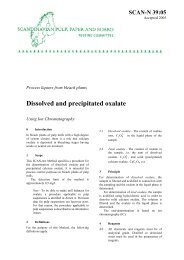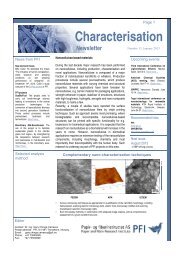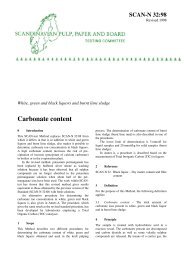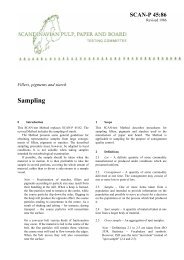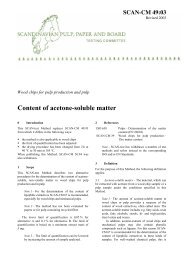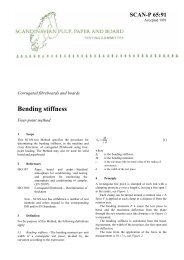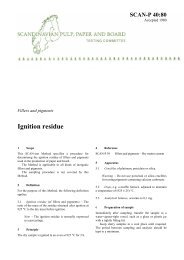SCAN-N 36:98 - PFI
SCAN-N 36:98 - PFI
SCAN-N 36:98 - PFI
Create successful ePaper yourself
Turn your PDF publications into a flip-book with our unique Google optimized e-Paper software.
<strong>SCAN</strong>-N <strong>36</strong>:<strong>98</strong><br />
Accepted 19<strong>98</strong><br />
Black liquors and sulphite spent liquor<br />
Sulphite, sulphate and thiosulphate ion concentrations<br />
0 Introduction<br />
This <strong>SCAN</strong>-test Method has been developed for the<br />
determination of sulphur compounds concentrations in<br />
black liquors and sulphite spent liquor by laboratories<br />
employing ion chromatography.<br />
The Method is not intended for the determination of<br />
hydrogen sulphide ion concentration in black liquor.<br />
Work within <strong>SCAN</strong>-test has shown that in that case<br />
results are obtained much more easily and more rapidly<br />
by potentiometric titration of hydrogen sulphide ions<br />
with silver nitrate solution, cf. <strong>SCAN</strong>-N 31:94.<br />
1 Scope<br />
This Method describes a procedure for the determination<br />
of sulphite, sulphate and thiosulphate ion concentrations<br />
in black liquors obtained and used in the kraft pulping<br />
process, or in the sulphite spent liquor obtained and used<br />
in the sulphite pulping process.<br />
The Method is applicable to liquors having a dry matter<br />
content below 20 %.<br />
Note – If the dry matter content of the liquor exceeds<br />
20 %, the liquor must be diluted with oxygen-free<br />
water (5.0) to a dry matter content of about 20 %.<br />
The procedure can, however, result in the underestimation<br />
of sulphite due to unintentional oxidation<br />
during the dilution.<br />
2 Reference<br />
<strong>SCAN</strong>-N 22 Black liquors – Dry matter content and<br />
fibre content<br />
3 Definitions<br />
For the purpose of this Method, the following definitions<br />
apply:<br />
3.1 Sulphite ion concentration − The concentration<br />
of ions present in the liquor.<br />
2-<br />
SO 3<br />
3.2 Sulphate ion concentration − The concentration<br />
of ions present in the liquor.<br />
2-<br />
SO 4<br />
3.3 Thiosulphate ion concentration − The concentration<br />
of ions present in the liquor.<br />
4 Principle<br />
2-<br />
SO 2 3<br />
The procedure is based on ion chromatography (IC). After<br />
dilution of the liquor in oxygen-free deionized water,<br />
isopropanol is added in order to stabilize the oxidizable<br />
hydrogen sulphite, thiosulphate and sulphide ions.<br />
5 Reagents<br />
All chemicals must be of analytical grade. Use oxygenfree<br />
water.<br />
Note 1 – Oxygen-free water can be prepared from<br />
distilled water either by boiling the water for<br />
15 min or by displacing the oxygen with nitrogen<br />
or argon gas. Protect from oxygen during storage.<br />
5.1 Isopropanol, CHO 3 8 , pro analysi.<br />
5.2 Oxygen-free water, containing isopropanol<br />
1 per cent by volume.
<strong>SCAN</strong>-N <strong>36</strong>:<strong>98</strong><br />
Page 2<br />
5.3 Concentrated standard sulphite solution, c(SO 3 ) =<br />
1000 mg/l. Dissolve (1,574 ± 0,002) g Na2SO, 3 previously<br />
dried for 2 h at 105 °C, in 100 ml isopropanol<br />
(5.1) and dilute with water (5.2) to the mark in<br />
a 1000 ml volumetric flask.<br />
Note 2 – Protect powdered Na2SO 3 from oxidation<br />
during storage.<br />
Note 3 – The solution should be used within one<br />
week.<br />
5.4 Standard sulphite solution, c(SO 3 ) = 20 mg/l.<br />
Transfer 20 ml of the concentrated standard<br />
solution (5.3) to a 1000 ml volumetric flask and fill<br />
to the mark with water (5.2).<br />
Check whether the standard sulphite solution<br />
contains any sulphate ions and, if it does, determine<br />
the sulphate ion concentration and calculate the real<br />
sulphite ion concentration in the standard sulphite<br />
solution.<br />
5.5 Concentrated standard sulphate solution, c(SO 4 ) =<br />
1000 mg/l. Dissolve (1,479 ± 0,002) g absolutely<br />
dry Na2SO 4 in a 1000 ml volumetric flask and fill<br />
to the mark with water (5.2).<br />
Note 4 – The solution is stable for at least one<br />
month.<br />
5.6 Standard sulphate solution, c(SO 4 ) = 20 mg/l.<br />
Transfer 20 ml of the concentrated standard<br />
solution (5.5) to a 1000 ml volumetric flask and fill<br />
to the mark with water (5.2).<br />
5.7 Concentrated standard thiosulphate solution,<br />
2-<br />
c(S2O 3 ) = 1000 mg/l. Dissolve (1,410 ± 0,002) g<br />
absolute dry Na2SO 2 3 in a 1000 ml volumetric<br />
flask and fill to the mark with water (5.2).<br />
Note 5 – The solution is stable for one week.<br />
5.8 Standard thiosulphate solution, c(S2O 3 ) =<br />
20 mg/l. Transfer 20 ml of the concentrated<br />
standard solution (5.7) to a 1000 ml volumetric<br />
flask and fill to the mark with water (5.2).<br />
Note 6 – The concentrations of the standard<br />
solutions can be adjusted as required.<br />
5.9 Eluent solution, for ion chromatography. The composition<br />
of this solution is highly dependent on the<br />
type of ion chromatography column used.<br />
Therefore, follow the recommendations given by<br />
the IC column supplier.<br />
2-<br />
2-<br />
2-<br />
2-<br />
2-<br />
Note 7 – Commercially available eluent solutions<br />
may be used.<br />
6 Apparatus<br />
Ordinary laboratory equipment and the following:<br />
6.1 Syringe, calibrated, volume between 20 μl and<br />
1000 μl.<br />
6.2 Serum flasks, with inert membrane stopper,<br />
volume 5 ml.<br />
6.3 Syringe, volume 5 ml.<br />
6.4 Balance, with a resolution of 0,1 mg.<br />
6.5 Ion chromatograph with a fractionating column,<br />
suitable for the determination of sulphite, sulphate<br />
and thiosulphate, and with a conductivity detector.<br />
Note – UV (ultraviolet radiation), wavelength<br />
200 nm, combined with conductivity, i.e. column-<br />
UV-conductivity, can also be used.<br />
7 Sampling and sample pre-treatment<br />
Black liquor and sulphite spent liquor are sensitive to<br />
oxidation by air. Prevent oxidation by keeping the<br />
sample bottles filled to the rim and tightly closed (12.1).<br />
Keep the bottles cold (between 4 °C and 8 °C). The<br />
sulphur compounds distribution does not change for at<br />
least two weeks if the liquor is stored in this way.<br />
Determine the dry matter content of the original<br />
sample according to <strong>SCAN</strong>-N 22.<br />
All samples for the determination of sulphur<br />
compounds have to be diluted. If the dry matter content<br />
exceeds 20 %, follow the instructions given in 7.1, and<br />
if the dry matter content is lower than 20 %, follow the<br />
instructions given in 7.2.<br />
7.1 Dilution at dry matter content >20 %<br />
Heat the sample in a water bath at 90 °C for 20 min,<br />
keeping the bottle closed during the heating period.<br />
Mix the sample carefully with a glass rod, especially<br />
sediment on the bottom of the sample container must be<br />
stirred and homogenized with the rest of the sample.<br />
Place a 100 ml volumetric flask on the balance. Tare<br />
the balance.<br />
Note 2 – It may be convenient to weigh the black<br />
liquor, if a plug is used. Tare the balance with the<br />
volumetric flask and the plug.<br />
Weigh carefully between 2 g and 10 g (m) of the homogenized<br />
sample into the flask to the nearest 0,1 mg and<br />
fill, as soon as possible, to the mark (V) with water (5.2).
<strong>SCAN</strong>-N <strong>36</strong>:<strong>98</strong><br />
Page 3<br />
Put a stirring magnet into the flask and close well with the<br />
plug. Place the flask on a magnetic stirrer and stir until the<br />
sample is totally homogenized. The sample is now ready<br />
to be analysed following the instructions given in 7.2.<br />
7.2 Pre-treatment at dry matter content 20 %<br />
Calculate the concentrations of the different sulphur<br />
compounds in the liquor, in milligrams per kilogram,<br />
from the equation:<br />
X<br />
s<br />
a⋅C⋅D⋅V<br />
=<br />
b⋅<br />
m<br />
[5]
<strong>SCAN</strong>-N <strong>36</strong>:<strong>98</strong><br />
Page 4<br />
where<br />
Xs<br />
a<br />
C<br />
D<br />
V<br />
b<br />
m<br />
is the concentration of the sulphur compound in<br />
the liquor as received, in milligrams per kilogram;<br />
is the peak area or peak height of the sample;<br />
is the concentration of the standard solution in<br />
milligrams per litre;<br />
is the dilution factor of the liquor sample solution<br />
(D = 1 if there is no dilution);<br />
is the volume in millilitres, by dilution of the<br />
original liquor (here 100 ml);<br />
is the peak area or peak height of the standard<br />
solution;<br />
is the weight of the original liquor, in gram<br />
If the results are to be expressed in milligrams per<br />
kilogram dry substance, calculate the sulphur compound<br />
concentration from the equation:<br />
X s ⋅100<br />
X = [6]<br />
f<br />
where<br />
X is the concentration of the sulphur compound in the<br />
liquor, in milligrams per kilogram dry substance;<br />
f is the dry matter content of the original liquor, in<br />
per cent;<br />
100 is the numerical factor which brings the result<br />
into dry substance.<br />
For the sulphite ion concentration, the sulphate ion<br />
concentration and the thiosulphate ion concentration,<br />
calculate the mean values of at least two parallel<br />
determinations. The results of the parallel determinations<br />
should not deviate by more than 5 % from their<br />
mean.<br />
Note – The sulphite ion concentration in black liquors<br />
and the thiosulphate ion concentration in sulphite<br />
spent liquors are often very low and difficult to<br />
determine. The coefficient of variation (CV) is also<br />
higher.<br />
10 Report<br />
The test report shall include reference to this <strong>SCAN</strong>-test<br />
Method and the following particulars:<br />
11 Precision<br />
11.1 Repeatability. One laboratory analysed three<br />
different spent liquors. Five parallel determinations were<br />
made in each case. The results were as follows:<br />
Sample 2-<br />
SO 3<br />
Black<br />
liquor<br />
Sulphite<br />
spent liquor<br />
mean,<br />
mmol/l<br />
Sample 2-<br />
SO 3<br />
Conc waste<br />
liquor<br />
CV*,<br />
%<br />
2-<br />
SO 4<br />
mean,<br />
mmol/l<br />
CV*,<br />
%<br />
2-<br />
SO 2 3<br />
mean,<br />
mmol/l<br />
CV*,<br />
%<br />
2,4 2,2 48 0,5 16 0,5<br />
100 0,5 120 0,7 8,9 0,8<br />
mean,<br />
mmol/kg<br />
CV*,<br />
%<br />
2-<br />
SO 4<br />
mean,<br />
mmol/kg<br />
CV*,<br />
%<br />
2-<br />
SO 2 3<br />
mean,<br />
mmol/kg<br />
CV*,<br />
%<br />
18 3,0 310 0,3 94 1,6<br />
11.2 Reproducibility. Three spent liquors were<br />
analysed in six laboratories. The results were as follows:<br />
Sample 2-<br />
SO 3<br />
Black<br />
liquor<br />
Sulphite<br />
spent liquor<br />
mean,<br />
mmol/l<br />
Sample 2-<br />
SO 3<br />
Conc waste<br />
liquor<br />
CV*,<br />
%<br />
2-<br />
SO 4<br />
mean,<br />
mmol/l<br />
CV*,<br />
%<br />
2-<br />
SO 2 3<br />
mean,<br />
mmol/l<br />
CV*,<br />
%<br />
4 17 39 3,4 14 6,2<br />
190 5,8 74 5,3 20 22<br />
mean,<br />
mmol/kg<br />
CV*,<br />
%<br />
2-<br />
SO 4<br />
mean,<br />
mmol/kg<br />
CV*,<br />
%<br />
2-<br />
SO 2 3<br />
mean,<br />
mmol/kg<br />
CV*,<br />
%<br />
60 26 270 1,9 100 7,5<br />
* CV is the coefficient of variation, i.e. the standard<br />
deviation divided by the mean value.<br />
Note – The contents of thiosulphate in sulphite<br />
spent liquor and sulphite in concentrated waste<br />
liquor are so low that they cannot be reliably<br />
determined by this technique.<br />
(a)<br />
(b)<br />
(c)<br />
(d)<br />
(e)<br />
date and place of testing;<br />
identification of the sample tested;<br />
information about whether the sample is diluted<br />
before analysis;<br />
the results to two significant figures;<br />
any departure from this Method and any other<br />
circumstances that may have affected the result.<br />
12 Literature<br />
12.1 Douek, M., Sullivan, J. and Ing, J. Effect of<br />
sample-related sources of error on analysis of pulp and<br />
paper mill process liquids by ion chromatography: Part 1 –<br />
Determination of sulphur species. TAPPI Pulping Conf.,<br />
Orlando 1991, Book 2, 911-923
<strong>SCAN</strong>-N <strong>36</strong>:<strong>98</strong><br />
Page 5<br />
<strong>SCAN</strong>-test Methods are issued and recommended by<br />
KCL, <strong>PFI</strong> and STFI-Packforsk for the pulp, paper and<br />
board industries in Finland, Norway and Sweden.<br />
Distribution: Secretariat, Scandinavian Pulp, Paper<br />
and Board Testing Committee, Box 5604,<br />
SE-114 86 Stockholm, Sweden.


